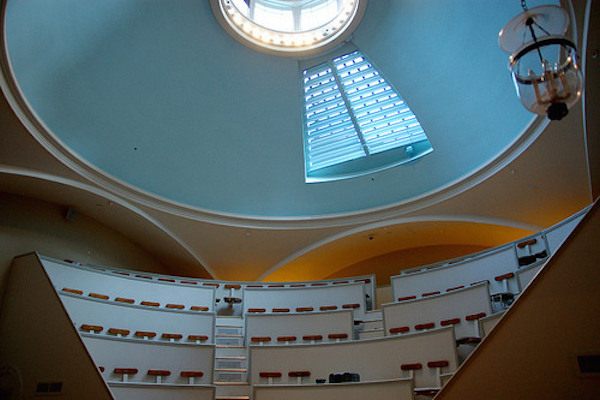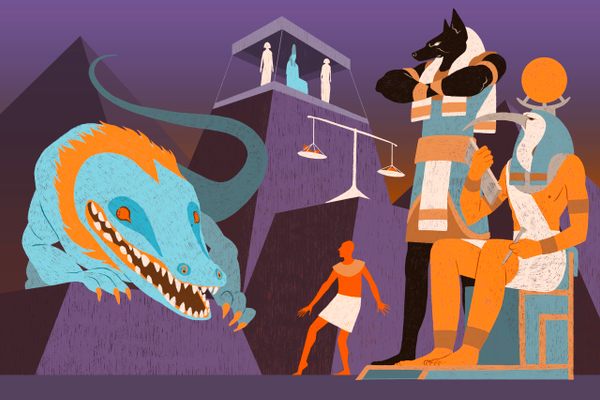Boston’s Ancient Necropolis Worker with a Broom Handle Neck
The oldest patient at Massachusetts’ General Hospital (MGH) does not lie in one of the beds in a patient room, rather he’s been in a display case in its original surgical amphitheater for more than a century. This surgical amphitheater is known as the Ether Dome because this is where, in 1846, William T.G. Morton demonstrated the first public surgery using anesthetic, or ether.
Dutch merchant Jacob Van Lennep imported this mummy to the United States in 1823, the first complete Egyptian mummy to arrive in the country. It was then gifted to MGH to help raise money for the hospital. This mummified body belongs to Padihershef, nicknamed Padi, a necropolis worker from the 7th century BC.
Mummy at the Ether Dome (photograph by Curious Expeditions)
Thanks to a grant, a team of researchers consisting of conservators, radiologists, and anthropologists was able to analyze and restore Padihershef’s mummy. Rajiv Gupta, assistant professor of radiology at Harvard Medical School (HMS) performed imaging analysis, that included CT scans and x-rays, in March of 2013. Jonathan Elias, director of the Akhmim Mummy Studies Consortium studied the body, wrappings, and coffin markings.
In January of 2014 the team presented its findings.
Mummy of a Necropolis Worker
Padihershef’s mummy was placed in two coffins, the styles of which date to the 25th dynasty, or about the 7th century BC. According to Elias, the markings on these coffins indicate that Padihershef’s family came from Heracleopolis Magna, south of Fayum, and that he lived and worked in Thebes.
Padi’s occupation translates to stonemason, but is a term used specifically for cemeteries. So he may have worked at the Theban necropolis searching for new burial spaces as well as looking for old tombs to recycle.
It’s ironic that a person who worked to give the dead peace and security in ancient Egypt would not receive either in his own afterlife.
Theban Necropolis (photograph by Vyacheslav Argenberg)
Padihershef’s Troubling Afterlife
Padihershef’s body sustained significant post-mortem damage in the 7th century BC before to being wrapped again in 1984 prior to a museum exhibit.
Soon after his death, Padi’s sternum was pushed inward and his ribs were dislocated. Elias argues that this damage may have been caused by decomposition and the weight of the natron, a drying substance used to mummify bodies during that period. If his corpse started to decompose before it was embalmed, the decaying body may not have been able to support the weight of the natron needed for the embalming process.
Padihershef’s mummy was chosen to be part of a temporary exhibit in Springfield, Massachusetts in 1984. Because the skull became separated from the torso, workers at the Ether Dome attempted restore the mummy for the upcoming travel and display. But they chose to reattach his head with a broom handle, a process that crushed Padihershef’s cervical vertebrae and pushed vertebral bodies into the wrappings.
Reconstruction of Padihershef’s face by Elias. (via Massachusetts General Hospital)
Analysis and Reconstruction
Previous investigations of Padihershef’s mummy include an examination of his head and neck in 1823, and radiological studies performed in 1931 and 1976. These analyses provided a foundation for the team’s work presented earlier this year.
Elias estimates that Padihershef was a male with Caucasoid features, who was about 5’9”, and between 20 and 30 years at the time of his death. Harris lines are present in both tibiae, which indicate stress caused by poor health or diet. The post-mortem damage to the remains made assessing cause of death difficult.
Embalmers removed all of the internal organs, except for the heart, and may have placed them in canopic jars. CT scans show intact nasal cells and brain tissue in the back of the skull, indicating his brain was not removed through the nose, a process called excerebration.
The embalmers used ancient reconstruction techniques to repair post-mortem damage to the body. Bandages were used to fill depressed cavities crushed by natron. Resin and linen were applied to rebuild the nose and ears that may have started to decay during the mummification process. A substance consistent with gypsum was used to preserve the eyes and create an exaggerated contour of the eye under the wrappings.
CT scans of the skull provided data for a 3D replica. Elias then used clay on the replica skull to reconstruct Padihershef’s face.
Conservator Mimi Leveque removed salts from the surface of the body and restored damaged areas of the wrappings and coffins. The Ether Dome now displays Padihershef’s mummy horizontally, in a climate-controlled case.
Neither the article nor Elias’ analysis say if the broom handle was removed.
Anubis supervising mummification in a 400 BC sarcophagus painting (photograph by André/Wikimedia)
For more fascinating stories of forensic anthropology visit Dolly Stolze’s Strange Remains, where a version of this article also appeared.
Morbid Mondays highlight macabre stories from around the world and through time, indulging in our morbid curiosity for stories from history’s darkest corners. Read more Morbid Mondays>













Follow us on Twitter to get the latest on the world's hidden wonders.
Like us on Facebook to get the latest on the world's hidden wonders.
Follow us on Twitter Like us on Facebook